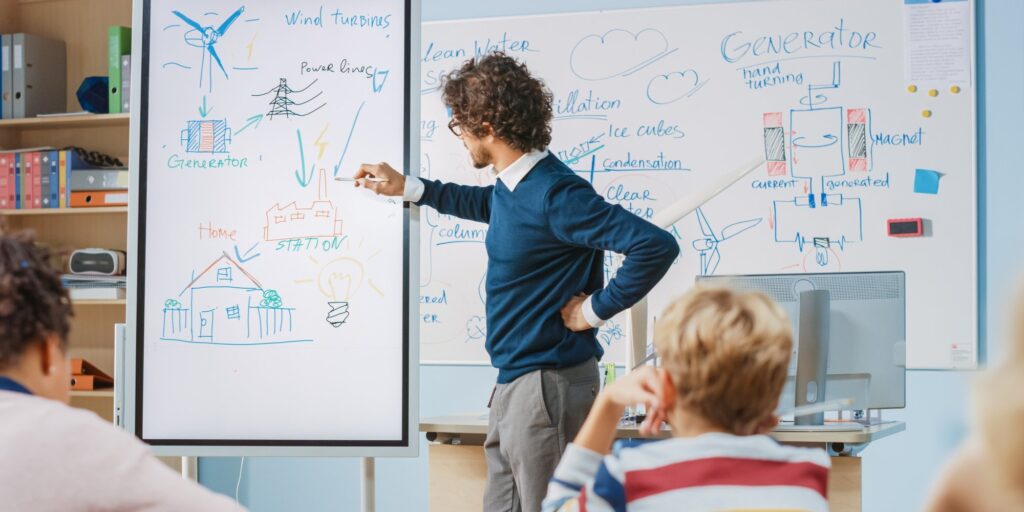The education environment is undergoing a tremendous transition, impacted by various novel tactics. As educators embrace mathematical teaching practices, they focus on imparting subject-specific knowledge and fostering a stimulating environment conducive to holistic student development.
These practices are designed to engage students actively, ensuring effective and enjoyable learning. The importance of technology in this shift cannot be emphasized. It has become integral in reshaping education delivery, allowing for a more interactive and personalized approach.
As we delve into the various strategies that define modern teaching, it becomes evident that adapting to these changes is essential for creating classrooms that are conducive to learning and prepare students for real-world challenges.
Digital Tools Enhancing Learning
The infusion of digital tools into the classroom has revolutionized traditional teaching methods. Tools such as smartboards, tablets, and educational software have made learning more engaging and tailored to individual student needs. This shift towards digital learning environments facilitates a more inclusive atmosphere where students of different learning paces can thrive.
Despite the numerous benefits, integrating technology may present specific challenges. The necessity for adequate training and infrastructure often constitutes a barrier to seamlessly adopting digital tools.
Nevertheless, the importance of technology in classrooms is widely acknowledged for its ability to provide students with a vast array of resources, enhancing both accessibility and depth of learning. Educators are encouraged to embrace these tools to better cater to the evolving dynamics of modern education.
Active Learning Techniques
Active learning represents a significant departure from the passive absorption of information typical of traditional education. By encouraging students to participate actively through discussion groups, simulations, and project-based assignments, educators can foster a more profound understanding and retention of knowledge.
These techniques empower students by placing them at the center of the learning process, allowing them to take charge of their educational outcomes. Successful implementation of active learning strategies can significantly improve student performance.
By prioritizing engagement, these methods ensure that students are not merely passive information recipients but active knowledge co-creators. The result is a more dynamic and immersive educational experience beyond conventional classroom boundaries.
Classroom Management Best Practices
Effective classroom management is pivotal in maintaining an environment conducive to learning. It involves setting clear expectations and fostering a sense of respect and community among students. When students understand the classroom norms and routines, they are more likely to engage productively with the curriculum and each other.
Establishing a positive classroom atmosphere requires a balance between discipline and empathy. Teachers who employ a compassionate yet firm approach often find that their students are more motivated and can better focus on their studies. This balance is essential for creating a learning space where students feel safe, valued, and academically challenged.
Fostering Critical Thinking
Critical thinking is a crucial skill that educators aim to develop in students. It allows them to assess data, make sound judgments, and solve complex challenges. Inquiry-based learning, debates, and case studies encourage students to question assumptions and explore multiple viewpoints.
By nurturing critical thinking, teachers help students build essential skills applicable in academic and real-world settings. This approach enhances individual learning outcomes and contributes to cultivating a thoughtful and informed society capable of addressing future challenges.
Collaborating with Parents and Community
Collaboration between educators, parents, and the community enriches the educational experience by providing a support network for students. Regular communication and involvement in school activities allow parents to take an active role in their child’s education, reinforcing learning in the classroom.
Community partnerships offer additional resources and opportunities for experiential learning. Schools collaborating with local groups and businesses can create a more connected educational environment.
Continuous Professional Development
For educators, remaining effective in the classroom requires ongoing professional development. Workshops, peer collaborations, and educational conferences are invaluable for sharing best practices and innovative strategies. These possibilities enable teachers to keep up with current educational trends and improve their teaching abilities.
The importance of professional development for teachers has never been more apparent as education demands continue to evolve. By investing in professional growth, teachers improve their efficacy and contribute to a more dynamic and responsive educational system, ultimately benefiting their students.
Future Trends in Education
As the education landscape evolves, future trends suggest an increased emphasis on personalized learning experiences facilitated by technological advancements. Adaptive learning technology, artificial intelligence, and virtual reality are poised to alter content delivery by providing tailored solutions to individual student needs.
Staying informed about these future trends empowers educators to anticipate shifts in the educational paradigm and adjust their teaching practices accordingly. This forward-thinking approach ensures they can provide students with the skills and knowledge necessary to succeed in an increasingly complex and interconnected world.






